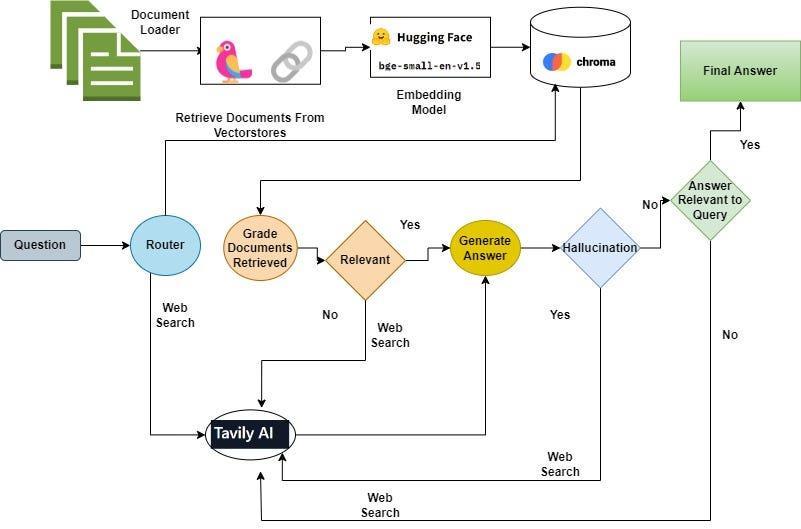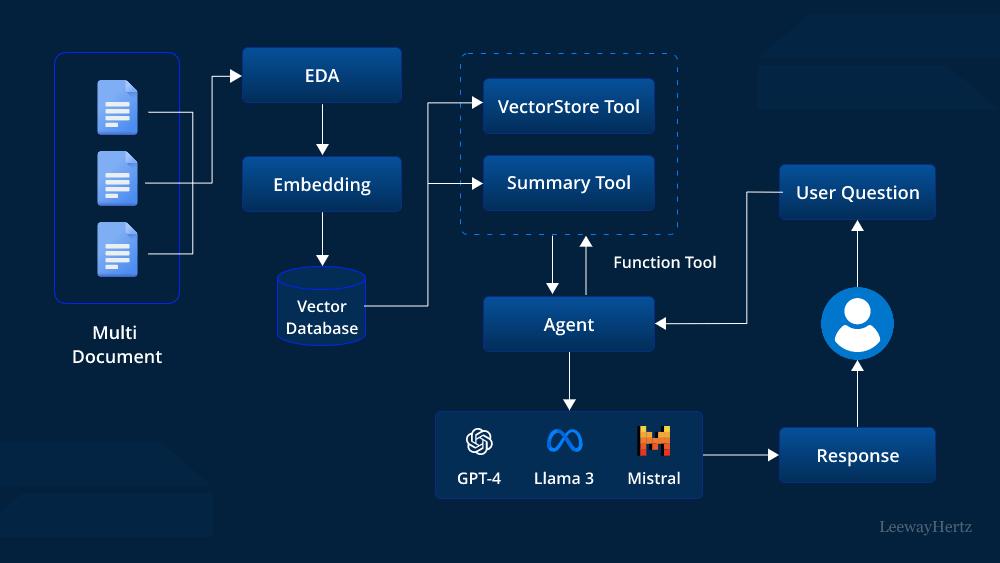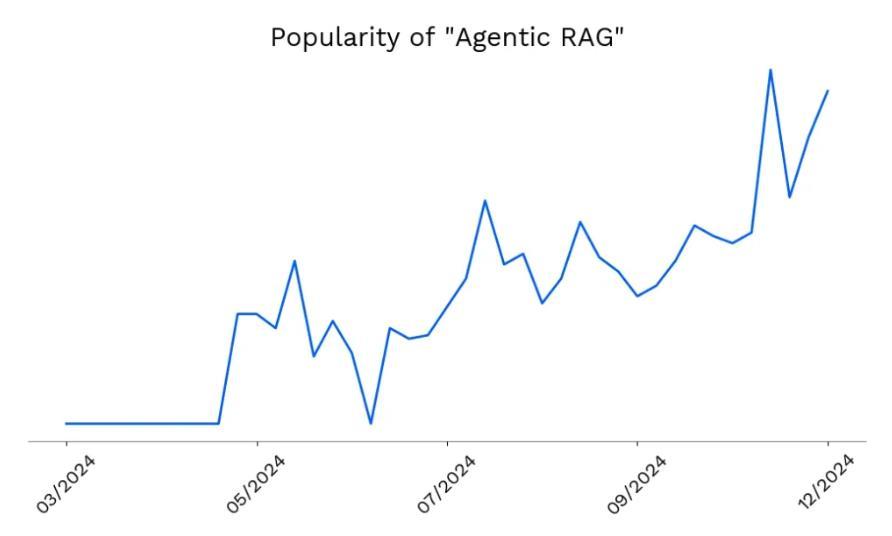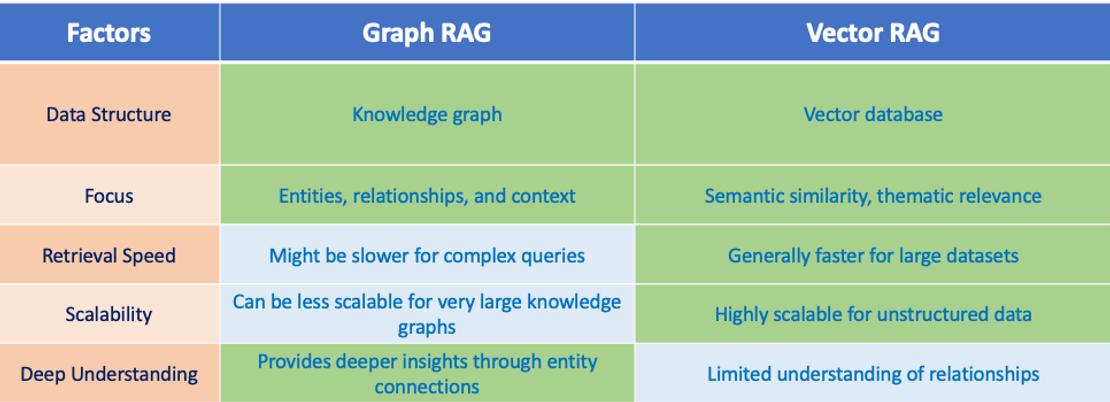
International Research Journal of Engineering and Technology (IRJET) e-ISSN:2395-0056
Volume: 12 Issue: 01 | Jan 2025 www.irjet.net p-ISSN:2395-0072


International Research Journal of Engineering and Technology (IRJET) e-ISSN:2395-0056
Volume: 12 Issue: 01 | Jan 2025 www.irjet.net p-ISSN:2395-0072
Meethun Panda
Associate Partner, Enterprise Technology, Data & AI at BAIN & COMPANY, Dubai, UAE Jumeirah, Dubai
ABSTRACT: This paper presents Agentic RAG, a new framework of retrieval augmented generation complemented with autonomous learning. Retrieval Augmented Generation (RAG) is a novel paradigm that unifies the advantages of generative and retrieval systems to improve the quality and the relevance of responses in Natural Language Processing (NLP)tasks.Wediscusskeyinnovations,highlightpracticalapplications,discusschallenges,andhighlightfutureresearch directions,allinformedthroughthenecessityforincreasedretrievalaccuracy,scalability,andethicalAIintegration.
KEYWORDS: AI,Agentic,Augmented,RAG.
TheRAGsystemexploitsavailableexternalknowledgefromaretrievalcomponent(e.g.,adatabaseorsearchengine)asan extensiontotherawknowledgepassedtothegenerativemodel.Thisintegrationempowersthesystemtodrawabundant externalknowledgewithadegreeofdynamism,capableofdealingwithmultiplesituation,andvariouscomplexquestions. RAG systems work in their traditional form where relevant documents or pieces of information are retrieved from externalsourcesandthenconsumedbyagenerativemodeltoproducecontextualresponses.
Indomainswheretherichnessofexternaldatacanenhancethesystem’sperformance,thismechanismhasemergedasa promising solution within areas such as those of question answering, dialogue systems, and information retrieval tasks. Although,traditionalRAGsystemsaretypicallyboundbyitsdependencyonthepredeterminedretrievalprocessbuthave difficultiesinleveragingnewexperiencestocontinuouslylearnfrom.
By incorporating agentic AI principles, the RAG framework the way in which retrieval augmented systems operate becomessignificantlydifferent. AgenticAIs aresystems thatcandosomeoftasksbutalsoperformactionsontheirown, withgoalandwithadaptingtothefuturedynamicallychangingenvironment.WithRAGembeddedwithagenticbehaviour, the system is able to retrieve, generate and adapt in a desired manner without constant human intervention by being drivenbyspecificobjectives

Fig.1RAGandAgenticRAG(DellTechnologiesInfoHub,2024)
Incorporatingautonomyintothesystemresultsinittransitioningfromareactivetooltoamoreproactiveagent,onethat learns from its experience and optimizes for performance in real time. An agentic RAG system is not bound to a predeterminedretrievalmechanism,butcanimproveitsqueryrefinement,selectionofmostrelevantdataandgeneration ofresponsesthataresuitedtoparticulargoalsandobjectives,whilegrowingitsknowledgeandcapability.

International Research Journal of Engineering and Technology (IRJET) e-ISSN:2395-0056
Volume: 12 Issue: 01 | Jan 2025 www.irjet.net p-ISSN:2395-0072
Thegoal ofAgenticRAGistobuilda systemthatisnotonlyreactive,butalsoadaptiveandgoal oriented.These systems arebuilttocontinuallyimprovebylearningfromtheirinteractionswiththeenvironment,andoutputs.Thegoal-oriented aspectisimportantinthatitallowsthesystemtofocusthework,selectthepriorityaswelltoplantheactionsandadapt changesinbehaviouramongothersasthesystemreceivesthenewinformation.
SuchisthepowerofAgenticRAGthatitisespeciallyusefulindynamicandever-changingfieldswherethecontextorthe requirement can vary so often. For example, in healthcare, a system that autonomously retrieves medical literature, suggests diagnostics, and adjusts its advice according to feedback from doctors or patients, but ensures that its advice is relevant and always up to date. An agentic RAG could retrieve case law, generate summarisation of case rulings and judicial decisions, and clarify their understanding of legal precedents based on the evolution of the rulings and judicial decisionsinalegalsystem.
An autonomous investment research platform in finance could, based on new market data and historical trends, continuouslylearnitsstrategyfrompastpredictionsandoutcomes,andcouldthemselvesadapttheirstrategiestothenew information.Whatisneededistocreateintelligentsystemsthatcanlearn,adapt,andmakeefficientdecisionsincomplex, realworldsituations
Agentic RAG (Retrieval-Augmented Generation) is a simple yet effective framework of advanced retrieval techniques combined with autonomous decision making that produces adaptive, goal-oriented intelligence. The use of these components,motivatedbyreinforcementlearningandcontextualawareness,makesitpossibleforthesystemnotonlyto seekinformation,buttouseittomakeintelligentdecisionsandadaptitsbehaviouraspartofcontinuousfeedbackloops. InthissectionweexplorethemainpartsofAgenticRAG,apowerfultoolincreatingAI.


International Research Journal of Engineering and Technology (IRJET) e-ISSN:2395-0056
Volume: 12 Issue: 01 | Jan 2025 www.irjet.net p-ISSN:2395-0072
RL strongly enhances a dynamic retrieval mechanism at the heart of Agentic RAG. A traditional retrieval system takes advantageofdefinedqueriesandstableindexationonthenewinformation,howeverinthecaseofrealtimesystemsthese solutionsareverylimited.Ontheother hand,insteadof choosingan offline policythatdoes notstoretheuser feedback, AgenticRAGsolvestheretrievalprocessusingRLtooptimallyupdatetheretrievalprocessinthecontinuousenvironment.
Where it’s possible something similar to the supportive curriculum is applied, making it possible for the system to learn from experience,and refine itsapproachto retrieve relevantinformationfrom the external environmentas well asfrom theactionsof thatsystem, withoutany need formanual intervention.Thesystem candynamicallytweak the parameters governingtheretrievalprocesstoproducemoreeffectivequeries,tofavoursometypeofinformationoverothers,tolearn tofilteroutunhelpfulorinferiormaterial.
RL driven retrieval mechanism runs in cyclical form. Initially, the system uses simple retrieval strategies; however, as it encountersitsenvironmentandreceivesrewardsorpunishmentforreturnedinformation,itlearnstochangeitsstrategy. Asinputschangethesystemcontinuestoconvergetowardsretrievingthemostpertinentdata.
Forapplicationswhichneedtoretrieverecentinformationorresponses tailoredtothecontextofthequery,thisadaptive retrieval process is highly valued. Consider healthcare domain, where a lot of medical knowledge changes continuously, thesystemshouldbelearningandlearningcontinuouslyhowtoretrievethelatestresearch,orcasestudies,ifoneknows abouta certain diagnosis In thelegal domainthesystemshouldbeabletosearch ofrelevantcaselaw not just fromany pointintime,butalsofromwithinthecontextofthelatestinterpretationsandrulingsofthelaw
Afterrelevantdata retrieval,AgenticRAGusescontextawaredecision-makinglooptodecidehowtoprocessandusethe information. The system’s goals and priorities, which are continually refined under the context of each query and the emergent mission goals of the task at hand, guide these decision-making loops. The context-aware loops give the involvement of the system in evaluating the harvested data, determining the relevance status, making the decision of creatingthebestresponsesthatareconsistentwiththestatedmission.
With context agentic RAG allows your system to make decisions in a wide range of scenarios. For example, for legal research, the system must learn if we want to know the general sense of a legal principle or the way this principle is appliedintheparticularcase.Forinstance,inahealthcarescenariothesystemmighthavetochoosewhethertofulfilthe most recent medical guidelines or think through a bigger picture of the patient’s medical history and symptoms. The system does not make these decisions blindly, they are dynamically changed by the context and outcomes to achieve alwaysactionsconsistentwiththemostrelevantandmostimmediategoals.
AgenticRAGintegratescontextawaredecisionmakingtochooseamongstitsresponsesinsuchawayastobiasoutcomes, toachievelongtermgoals.Feedbackloopsevaluatedcontinuouslybythesystemastotheeffectivenessoftheirdecisions and adjusting them as applicable to gain the best service for themselves. The system’s performance and the appropriateness of the produced content in given context provide information to inform these feedback loops for more delicateunderstandingabouthowtoactinfurtherinteractions.
An analysis of an Agentic RAG system architecture is laid out to seamlessly combine the retrieval and generation components and to provide decision making skill with reinforcement learning and context awareness abilities built into the architecture. It bases on numerous interconnected layers, allowing dynamic retrieval, decision making and iterative learning

Volume: 12 Issue: 01 | Jan 2025 www.irjet.net p-ISSN:2395-0072

Thefirstlayeroftheretrievalsystememploystraditionalsearchtechniquesandself-guidedquerycreationasitinterfaces with an external knowledge base or corpus of data. The RL-driven mechanism is useful to this layer as it continuously adapts query strategy according to retrieval performance. The retrieved data then feeds into the next layer where the makingofdecisiontakesplace.
After retrieving data,thesystem'sdecision-makinglayerthen evaluates retrieved data with the task athand. It usesthis information,thenprioritizesitaccordingtoitsrelevancetothesystem’sgoals.Inthiscase,thesystemgetsinvolvedwith the context aware loops, where the system continues to refine its decision making and make further decisions from the feedback of previous actions. At this stage the system has shown the agentic principle, in autonomous fashion, deciding howtousetheretrievedinformationtoproducecontextuallyrelevantandgoal-orientedresponses.
Thegenerationlayertakestheretrieveddataandusesitscontextawaredecisionstogeneratearesponse.Thiscanbetext generation, decisionmaking suggestionsor actionsontheoutsideofthe system’senvironment.Importantly,thislayeris iterativeandfeedbackfromgeneratedcontentisfedintofuture,futureretrievalanddecision-makingstrategies.Itgivesa system a natural cyclical nature, something which will ensure that the system can continuously adjust itself, refine its strategies,andcontinuouslygetbetteratresponding.
ThesecomponentscometogethertomakeanAgenticRAGarchitecturethatcanretrieve,generate,andadaptinrealtime independently This architecture is flexible enough such that it can be adapted based on the required domain or applicationspecificallyanditincludesalloftherequiredcomponentsforiterativelearningandcontinuousimprovement. The net effect is a model that can not only produce high quality responses, but learns from its environment to adapt its behaviourinmorepromisingwaysnomatterthestateoftheworld
The most important element of Agentic RAG is the change from fixed retrieval to the author generation of the self. TraditionalRAGsystemsaredependentonpredefinedformulatingmechanismsforquerieswhichcanbeformulatedfrom pre-defined inputs data and external knowledge bases. These systems use fixed strategies to retrieve information that is mostlikelyrelevant

International Research Journal of Engineering and Technology (IRJET) e-ISSN:2395-0056
Volume: 12 Issue: 01 | Jan 2025 www.irjet.net p-ISSN:2395-0072

4RAGProductionGraph(Medium,2024)
static retrieval exhibits such a limitation that it often cannot support fine grained or dynamic contexts. However, unlike present RAG systems, Agentic RAG allows the system to autonomously create queries in real-time. It is driven by this transitionpoweredbyreinforcementlearningwherebythesystemgetsempoweredtoindividuallyevaluatetherelevance ofretrieveddataandrevisethequerygeneratedinresponsetofeedback.
Because Agentic RAG systems are self-directed, they can continually fine tune the retrieval process by self-generating query. Through interaction with the environment, the system elaborates its query generating strategies which are more aligned to specific objectives and contexts. This innovation is just critical for applications where the information is constantlyupdatedorrefinedinresponsetonewinputs.
Ifwetaketheexampleofthefield,inhealthcareonesuchsystemmighthavetocomeupwithqueriessuchasqueryingon themostrecentmedicalresearchaboutapatient’sconditionandmedicalhistory.Throughtheshiftawayfromstaticquery formulation, Agentic RAG systems become better enabled to deliver more personalized, more timely and more accurate information.
for iterative learning, the beginning of Agentic RAG contains feedback loop mechanisms. With traditional systems, when the data is fetched and the response is created, there is no mechanism to improve the process. The adaptive nature of AgenticRAGisimplementedthroughcontinuousfeedbackloopswhicharecentralfeaturesofthesystem.
Theseloopsenablethesystemtoevaluateretrievedandgeneratedcontentwithrespecttodesiredgoalsandoutcomes.On thisfeedback,thesystem’sperformanceisrefinedsimultaneouslyontheretrievalandgenerationprocesses.
The iterative learning model is a dynamic learning model where the system is not static but every interaction with the systemenvironment,thesystemevolves.Thefeedbackmechanismthentellsthesystemwhatoutofdate,redundantdata itbroughtback,sothatthesystemcancorrectfuturesearchanddataselectiontypes.
Thisenablesthesystemtolearnfromtheactionexperienceofitspreviousactionsandtoadaptitsdecision-makingover time, so that its action becomes better aligned with the goal. This particular process has a lot of merit in dynamic fields such as finance or the law, because the system must be capable of adjusting to new developments, trends or legal precedentsatregulartimes
Another cornerstone of the innovations within Agentic RAG are in goal prioritization and contextual adaptation. In traditionalretrievalsystems,whenthereislittleornoconsiderationgiventothecontextorthelong-termgoalsforagiven query, the information retrieval system is perceived to be working well. Agentic RAG takes the next step and is more

International Research Journal of Engineering and Technology (IRJET) e-ISSN:2395-0056
Volume: 12 Issue: 01 | Jan 2025 www.irjet.net p-ISSN:2395-0072
sophisticated, in that it does not just pull up useful data, it also negotiates how to plan its actions cognitively given the contextandoverallgoalsthatneedtobeaccomplished.
Itallowsthesystemtohavepriorities,toweightrade-offs,andfigureouthowtodoitinadynamicmannertoalwaysmeet theirendgoalsbetter.Byensuringthesystemcanadapttochangingconditions,oreverevolvingrequirements,thesystem can maintain its suitability for the intended purpose. To take an example, in a legal research application, Agentic RAG systemwouldbeabletoprioritiseretrievalofcaselawrelevanttocurrentlitigationorspecificjurisdiction.
Thisisfurther refined bythegoal prioritization mechanismsuchthatthesystemcandecide whichpiecesof information aremostimportanttothetaskathand.AgenticRAGsystemscanintegrategoal prioritizationwithcontextual adaptation to tailor their own behavior for particular applications requiring real time medical decisions, financial analysis, and providing personalized legal advice. As a consequence, we obtain more intelligent, adaptive, and goal-oriented systems thatareconstantlytunedinreactiontotheirinteractionsandobjectives
IV.PRACTICAL
Healthcare
Adaptive intelligence in medical diagnosis, which we propose can be enabled with agentic RAG, has the potential to revolutionize healthcare. Current diagnostic systems rely solely on traditional static based algorithms or pre-defined decision trees, imposing a constraint that may not be applicable to sophisticated medical problems. On the other hand, Agentic RAG systems are capable of extracting the most relevant medical research, patient histories, and clinical data, in real-time,andadaptivelytoarangeofdiagnosticneeds.

AgenticRAGsystemscontinuouslylearnfrompatientdata,treatmentoutcomesandexternalmedicalknowledgetorefine theirdiagnosticrecommendations,inordertoremaincurrentwiththestateoftheartandtailoredtoindividualcases.This dynamicaladaptabilitydemonstratestheutilityofthesystemforphysicianstoimprovepatientcareoutcomesandtohelp themmakebetterdecision

International Research Journal of Engineering and Technology (IRJET) e-ISSN:2395-0056
Volume: 12 Issue: 01 | Jan 2025 www.irjet.net p-ISSN:2395-0072
Sinceworkinginthisfield,wehaveseenthatAgenticRAGcanalsohelpinmakingtheprocessofcaselawsummarization faster and more effective by performing automatically retrieving sound legal precedents, and synthesizing them into concise, context specific summaries. Traditional legal research is time consuming and frequently requires an in-depth knowledgeofthecomplexcaselaw.
Throughembeddingdynamicretrievalmechanismsandself-directedquerygeneration,AgenticRAGsystemscanidentify quickly the most relevant legal cases toward a query The systems are able to offer accurate summaries, and adapt their responses to legal practitioners' special requirements. In fact, lawyers can save precious time, improve their research effectiveness,andmakebetterdecisions.
Practically, Agentic RAG can be used in the finance industry, where the intelligent platforms for autonomous investment researchdevelopmentarewellsuited.Traditionalinvestmentresearchisveryreliantonhumananalystswhoscourhuge amounts of data and get insights from it. Agentic RAG enables investment platforms with the ability to autonomously retrieve market data via scraping, retrieve and analyse macroeconomic data and company reports, and dynamically generatequeriestoidentifymarkettrendsandopportunities.
The system’s ability to tackle goals such as to maximize returns or minimize risks enables it to adjust to changing marketconditionsandgeneratesrealtime,personalizedinvestmentrecommendations.AgenticRAGDriveplatformslearn continuously from market shifts and past investment outcomes for better, more efficient ideas on the investment strategies

Fig.6AgenticRAGPopularity(ResearchAIMultiple,2025)
An important difficulty associated with the adoption of Agentic RAG involves a trade-off between system latency and retrieval accuracy. Since the accuracy of the information to be retrieved is essential to provide good inputs for decision makinginAgenticRAGsystems,theretrieval andgenerationprocessesmustbeinreal time.However,quicklyretrieving themostrelevantdatafromvastandcomplexexternalknowledgesourcesisaverybigproblem.

International Research Journal of Engineering and Technology (IRJET) e-ISSN:2395-0056
Volume: 12 Issue: 01 | Jan 2025 www.irjet.net p-ISSN:2395-0072
However,theentiresystemcouldbeunderminediftheretrievalmechanismdoesn’tefficientlyhandlewhatwouldbethe most pertinent information or generates irrelevant queries. The system might need to run multiple retrievals to get its desireddata.Latencyaddedinthatisalsonotfavourableforrealtimeapplications suchashealthcarediagnosisortrade financing where you have to get the response instantly. However, it is this key hurdle in the widespread adoption of AgenticRAGsystems.
Oneofthebiggestchallengesencounteredisthefactthatsystemsarelimitedintheirscalability.Withtheincreasingscope ofapplicationsofAgenticRAG,thesystemsmustalsobeabletohandleincreasing,diverseinputsacrossdifferentdomains. Asthevolumeofdatatoprocessincreases,thescalingwillbottleneckintofasterretrievalandgenerationprocessingdue toscalabilityissuesintheretrievalandgenerationprocesses,slowingresponsetimesdownordecreasingperformance

VI.FUTURE DIRECTIONS
Future opportunities for investigating Agentic RAG will need the incorporation of multi modal data to generate richer output. These applications need responses that are richer, contextually aware, and can be addressed through these systemsasweuseawidespectrumofdatasources(text,images,audio).Moreover,studyingthemoreadvancedfeedback loops would improve continuous learning, so that systems can deal better with dynamic environments. They could research ways to improve the feedback to make it quick, and still remain accurate. Finally, the fields of cross union application and integration of ethical AI principles must be explored, such that these adaptive systems embody in their design,fairness,transparency,andaccountabilityinmultiplemarkets
Combining retrieval augmented generation with agentic, autonomous, and adaptive intelligence is transformative, and retrieval augmented generation (RAG) combined with agentic RAG is one such approach. Agentic RAG systems have the potential to aid decision making in a wide range of domains, including healthcare and finance, by leveraging dynamic retrieval mechanisms, self-directed query generation and iterative learning. Although still facing challenges such as retrieval accuracy and scalability, the improvements in reach and continuous improvement in the integration of multi modaldatapromisemajorimprovementsinadaptive,goal-orientedAIsystems
[1] Singh, A., Ehtesham, A., Kumar, S., & Khoei, T. T. (2025). Agentic Retrieval-Augmented Generation: A Survey on AgenticRAG. arXivpreprintarXiv:2501.09136 https://doi.org/10.48550/arXiv.2501.09136
[2] Bousetouane,F.(2025).AgenticSystems:AGuidetoTransformingIndustrieswith Vertical AIAgents. arXiv preprint arXiv:2501.00881.https://doi.org/10.48550/arXiv.2501.00881
[3] Bousetouane,F.(2025).PhysicalAIAgents:IntegratingCognitiveIntelligencewithReal-WorldAction. arXiv preprint arXiv:2501.08944 https://doi.org/10.48550/arXiv.2501.08944

International Research Journal of Engineering and Technology (IRJET) e-ISSN:2395-0056
[4] Finsås,M.,&Maksim,J.(2024). OptimizingRAGSystemsforTechnicalSupportwithLLM-basedRelevanceFeedbackand Multi-AgentPatterns (Master'sthesis,NTNU).https://hdl.handle.net/11250/3160478
[5] Li,X.(2025,January).AReviewofProminentParadigmsforLLM-BasedAgents:ToolUse,Planning(IncludingRAG), and Feedback Learning. In Proceedings of the 31st International Conference on Computational Linguistics (pp. 97609779).https://aclanthology.org/2025.coling-main.652/
[6] Mitra,A.,DelCorro,L.,Zheng,G.,Mahajan,S.,Rouhana,D.,Codas,A.,...&Awadallah,A.(2024).Agentinstruct:Toward generative teaching with agentic flows. arXiv preprint arXiv:2407.03502 https://doi.org/10.48550/arXiv.2407.03502
[7] Li, X. (2024). A Review of Prominent Paradigms for LLM-Based Agents: Tool Use (Including RAG), Planning, and FeedbackLearning. arXivpreprintarXiv:2406.05804 https://doi.org/10.48550/arXiv.2406.05804
[8] Ravuru, C., Sakhinana, S. S., & Runkana, V. (2024). Agentic retrieval-augmented generation for time series analysis. arXivpreprintarXiv:2408.14484 https://doi.org/10.48550/arXiv.2408.14484
[9] Lee, M. C., Zhu, Q., Mavromatis, C., Han, Z., Adeshina, S., Ioannidis, V. N., ... & Faloutsos, C. Agent-G: An Agentic FrameworkforGraphRetrievalAugmentedGeneration.https://openreview.net/forum?id=g2C947jjjQ
[10] An, Z., Ding, X., Fu, Y. C., Chu, C. C., Li, Y., & Du, W. (2024). Golden-Retriever: High-Fidelity Agentic Retrieval Augmented Generation for Industrial Knowledge Base. arXiv preprint arXiv:2408.00798 https://doi.org/10.48550/arXiv.2408.00798
[11] Das,R.,Maheswari,K.,Siddiqui,S.,Arora,N.,Paul,A.,Nanshi,J.,...&Sengupta,D.(2024).Improvedprecisiononcology question-answeringusingagenticLLM. medRxiv,2024-09. https://doi.org/10.1101/2024.09.20.24314076
[12] Khanda,R.(2024).AgenticAI-DrivenTechnicalTroubleshootingforEnterpriseSystems:ANovelWeightedRetrievalAugmentedGenerationParadigm. arXivpreprintarXiv:2412.12006. https://doi.org/10.48550/arXiv.2412.12006
[13] Jang, J., & Li, W. S. (2024, December). AU-RAG: Agent-based Universal Retrieval Augmented Generation. In Proceedings of the 2024 Annual International ACM SIGIR Conference on Research and Development in Information RetrievalintheAsiaPacificRegion (pp.2-11).https://doi.org/10.1145/3673791.3698416
[14] Alam, H. M. T., Srivastav, D., Kadir, M. A., & Sonntag, D. (2024). Towards Interpretable Radiology Report Generation via Concept Bottlenecks using a Multi-Agentic RAG. arXiv preprint arXiv:2412.16086 https://doi.org/10.48550/arXiv.2412.16086
[15] Li, X., Dong, G., Jin, J., Zhang, Y., Zhou, Y., Zhu, Y., ... & Dou, Z. (2025). Search-o1: Agentic Search-Enhanced Large ReasoningModels. arXivpreprintarXiv:2501.05366.https://doi.org/10.48550/arXiv.2501.05366
Volume: 12 Issue: 01 | Jan 2025 www.irjet.net p-ISSN:2395-0072 © 2025, IRJET | Impact Factor value: 8.315 | ISO 9001:2008 Certified Journal | Page739